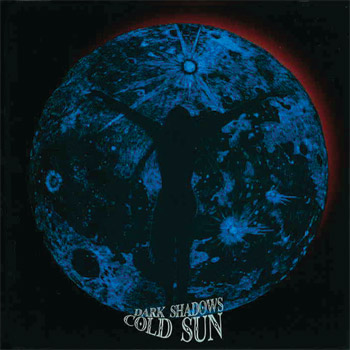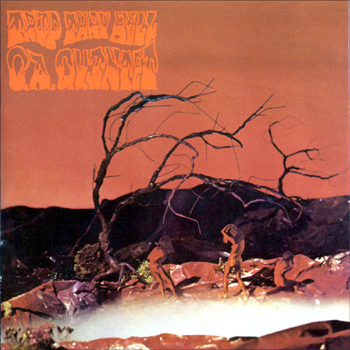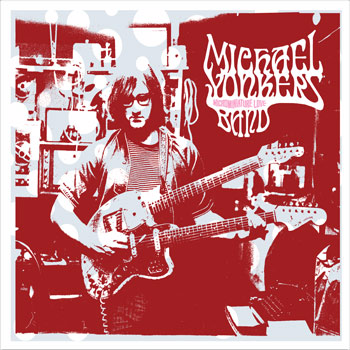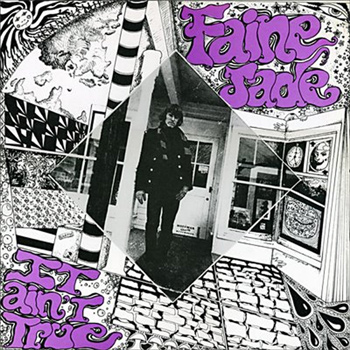Cold Sun “Dark Shadows”

Never seeing an actual release until 1989, Cold Sun is a devastating slab of Texas psych and the sickest of lost gems. I can’t say I’ve ever been so moved by feedback and noise in my life. The long awaited reissue from World In Sound sheds some long due light on this beauty and is one of the best we’ve seen in 2008.
The record is sometimes referred to as just Cold Sun; years later the band was unofficially renamed Dark Shadows which was printed on the sleeve as a pseudo album title. Interestingly, both names are derived from the same mythology that inspired the band Mu. Many of the details to the Cold Sun story have been lost in the cracks but Patrick the Lama’s (Acid Archives) essay is a noble piece of research and comes highly recommended for those interested in the history of this band.
I never thought hard psych could sound gorgeous. The magic of the record, for me, is in Billy Miller’s (who wrote most of the material and spearheaded the band) electrified autoharp. This instrument sounds like no other, but I initially mistook it for a distorted Fender Rhodes. The instrument is rarely strummed in the traditional autoharp style but finger-picked like a real harp, the sound full of sustain and grit. Add Tom McGarrigle’s stabbing guitar leads, Mike Waugh’s deep, dark, progressive bass lines, and Hugh Patton’s energy behind the kit and you’re hearing everything the third Elevators album needed to be. It’s clamorous and peyote-drenched and hard but also tender and beautiful.
The World In Sound reissue has great sound, excellent liners (in which Jello Biafra calls Dark Shadows “the best psychedelic album I know of”) and two badass live cuts from 1972. I found the CD available at Heyday Mail Order, but for the LP version you’ll have to wait til the end of the month (and fight for it).
Cold Sun fans? Come and testify!
“Here In The Year”
![]() CD Reissue | 2008 | World In Sound | buy from heyday ]
CD Reissue | 2008 | World In Sound | buy from heyday ]
![]() Vinyl Reissue | Coming Soon | go to world in sound ]
Vinyl Reissue | Coming Soon | go to world in sound ]
Also Recommended





I’m gonna have to speak out & give this record my fullest recommendation. This kind of album is one of those few that you hear of in hushed tones & when you finally check it out it lives up to everything you hoped for and more. The dark, discordant weaving of reverb drenched instruments in South Texas always gives me shivers…
“you have seen the eyes of the gecko/staring out watching/from the crack in the wall”
Brendan,
Nice review, this really is a lost gem. I heartily recommend this to anyone with an interest in psych or out there rock n roll.
Incredible lost and found treasure, highly recommended for any fan of 13th Floor Elevators/Roky Erickson or Velvet Underground hypnotic and obscure sounds. A very special record indeed. Great review by the way, very helpful…
What year was it recorded?
Nevermind, it’s 1970.
I got copy of the Cold Sun/Dark Shadows cd directly from Billy Miller and Jello Biafra a couple weeks ago at a show where Billy was playing with Powell St. John and the Aliens. (BTW–a great show to see if you ever get the chance). I put the cd into my car’s changer for the drive home…. All I can say is that I was not prepared for what I heard. I literally almost crashed my car on the Bay Bridge. The songwriting is strong and the playing even better. But who knew Billy could sing too?! Did Jello develop his own singing voice by studying this album in his pre-Kennedy days? Get this album, there’s nothing like it.
On the strength of Brendan’s review and of positive mentions in The Acid Archives and Fuzz Acid & Flowers, and after a lot of deliberation, I’ve just bought this album and I’m damn glad I did. It’s hard to find, and it cost top dollar (or top GBP, anyway), but it’s worth every penny. In fact I wish I’d found it before Brendan, so I could have written the main review (which is not to knock B’s excellent post). This is the most stoned music I’ve ever heard, outside of their Texas neighbours the Elevators (with whom Billy Miller had links, and would later guest on Roky’s solo stuff) and the Holy Modal Rounders. The case notes by Jello Biafra hint (well, much more than hint) that the band members were all off their faces on peyote when they recorded these tunes around 1970, and from the lyrics and the vocals I can believe it. Yet the playing is amazing. To play autoharp like that Miller must have been reasonably compos mentis: it’s common in old-time Appalachian music to play fingered arpeggios and tunes on a simple diatonic three-bar harp, but to do something similar on a chromatic fifteen-bar Oscar Schmidt with incomplete chromatic scales takes a knowledge of the instrument and an accuracy of fingering I have yet to work out. (I can play the basics of autoharp myself – alternating thumb bass and brushed chords – but nothing remotely like what Miller does here.) The use of the autoharp in rock music of this type is unprecedented and unrepeated, and though amplified harps are now commonplace, back in the day Miller had to electrify his instrument himself, and heaven knows how he did it. The limited chord palette of the instrument means that the chordal structures of the tunes are simple and repetitive, but the variety of keys and metres more than compensates. And there’s more, much more. Tom McGarrigle’s guitar playing owes more to John Coltrane and Miles Davis than to any guitar player, being all linear lines with hardly any chords, and an absolute truckful of styles and effects – perhaps only Hendrix can compare for pure sonic variety and inventiveness, though their styles are totally different. The bass parts by Mike Waugh are similarly dark and rubbery, and much of the bass is played or doubled by Miller on the harp’s bass strings, while drummer Hugh Patton is marvellously metronomic most of the time but occasionally lapses into freak-out rolls round the kit in unexpected places that would have had Keith Moon dumbfounded. The combination of melodic, minimalist motifs with gratuitous amplified noise is truly exhilarating. It’s clear this outfit owes a big borrow to the Doors and the Velvets, yet the end product is totally unique. What’s also amazing is that these recordings failed to find a release of any sort in 1970, and were only put out over twenty years later at the insistence of latecomer bassist Michael Ritchey, and initially against the wishes of Miller who had, despite dissatisfaction with the recorded material, held on to the master tapes. We should be grateful that he did. If you value truly original and challenging music, BUY THIS RECORD. For a lot more info (although the article pre-dates the CD reissue) go to the excellent webpage by Patrick Lundborg linked to in Brendan’s review above, which gives a fine history of Miller’s outfit in the wider context of the Texas psych scene in which they operated.
It’s one of the best psychedelic releases ever!
it’s the best pure psychedelic Lp ever !!
No Blues
No Music Hall / Vaudeville
No Beatles
No Beach Boys
No Nothing……. just pure peyote
In 1000 years from now when you will need to know what was psychedelic music in the 20th century you will have to listen to this Lp, nothing else !
PS please one day write something about the greatest psychedelic Beatles-inspired Lp ever…. ZERFAS !!
Another one I’ve never heard of, but Zerfas sounds very interesting according to reviews on 700 West, The Acid Archives and elsewhere. Appears to be available on more than one CD reissue: suggest avoiding the Radioactive one, which according to a review on Amazon.com is a really poor quality transcription from vinyl. (That label gets a poor rep elsewhere, as we know.) If I can get a copy on another imprint I might put up a review – watch this space.
Further to my comment above, I just caught an old TV segment of the Lovin’ Spoonful playing “Do You Believe In Magic” from around 1965 or 66, with John Sebastian playing a conspicuously amplified 15-bar autoharp which had a panel with a couple of large controls on it. Thus Sebastian did precede Billy Miller as a rock autoharp user, though I doubt he could work the instrument as comprehensively as Miller did. This also shows that amplified harps were available in the mid 60s, though I’d guess only as one-off custom jobs rather than as production models. Anyone know of any other users of the autoharp in rock?
There was a folk psych album by a group called Michaelangelo – with a female lead singer. I know they reissued this disc but I believe someone played the autoharp on that album. It’s not the same Michael Angelo as the private press LP in 1977 which is a pretty good psych album. But Michaelangelo, the album with the autoharp, is a mixture of originals and instrumentals that’s actually decent.
Found your Michaelangelo, J, it’s entitled One Voice Many and dates from 1971. Re-reissued 2009 on Rev-Ola (and hence I don’t think it’s a bootleg). On the basis of your comment and flattering reviews on Amazon and in Fuzz Acid & Flowers – and a deep fascination with the autoharp – have ordered it. If it’s up to scratch, look out for a review.
Hi Len,
I don’t own the disc but have heard a majority of the songs. I remember seeing it in many of the NYC (I live close to NYC) music stores. The cover is a bit misleading and gaudy as it looks like yet another Jefferson Airplane wannabe group….but it’s more in the folk-rock tradition…The Acid Archives book had it amongst it’s 50 good LP’s (vinyl) that one can still buy for under $10. I remember Son “We’ve We’ve Kept The Room Just The Way You Left It” being a good track.
I think Hearts & Flowers may also have some autoharp on their two albums – the country/folk-rock group.
Q: What’s the difference between an autoharp and a Harley-Davidson? A: You can tune a Harley-Davidson. (The old ones are the best . . .)
My brain cells are half fried half melted from this spectral peyote transmission.
This music seemed to be lurking in the cracks waiting for the right time to reveal itself to me as I only recently discovered it. An incredible example of pure and true head music from the 70s.
I just wanted to thank you for this gem of a site, a wonderful selection of albums, very good reviews and so much albums that just blew me away!!! It’s great to listen and discover such acts as Cold Sun. Keep up the fantastic work!
Greetings from Paris.
yvan
Edward Hermann used an amplified autoharp EXTENSIVELY in the 1950’s in the soundtrack AND opening theme of a TV show you all may remember. The title of this show was … “The Twilight Zone”. Hermann did the music for the show and wrote the theme. I am not sure who played the autoharp.